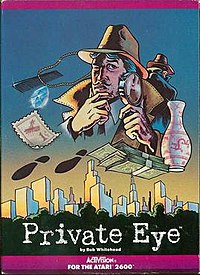
The Atari 2600 is a home video game console developed and produced by Atari, Inc. Released in September 1977 as the Atari Video Computer System, it popularized microprocessor-based hardware and games stored on swappable ROM cartridges, a format first used with the Fairchild Channel F in 1976. The VCS was bundled with two joystick controllers, a conjoined pair of paddle controllers, and a game cartridge—initially Combat and later Pac-Man. Sears sold the system as the Tele-Games Video Arcade. Atari rebranded the VCS as the Atari 2600 in November 1982 alongside the release of the Atari 5200.

Adventure is a video game developed by Warren Robinett for the Atari Video Computer System and released in 1980 by Atari, Inc. The player controls a square avatar whose quest is to explore an open-ended environment to find a magical chalice and return it to the golden castle. The game world is populated by roaming enemies: three dragons that can eat the avatar and a bat that randomly steals and hides items around the game world. Adventure introduced new elements to console games, including enemies that continue to move when offscreen.

Pitfall! is a video game developed by David Crane for the Atari Video Computer System and released in 1982 by Activision. The player controls Pitfall Harry, who has a time limit of 20 minutes to seek treasure in a jungle. The game world is populated by enemies and hazards that variously cause the player to lose lives or points.

Tennis is a sports video game for the Atari VCS which was written by Activision co-founder Alan Miller and published by Activision in 1981.

Ghostbusters is a licensed game by Activision based on the film of the same name. It was designed by David Crane and released for several home computer platforms in 1984, and later for video game console systems, including the Atari 2600, Master System and Nintendo Entertainment System. The primary target was the Commodore 64 and the programmer for the initial version of the game was Adam Bellin. All versions of the game were released in the USA except for the Amstrad CPC and ZX Spectrum versions, which were released only in Europe, and the MSX version, which was released only in Europe, South America, and Japan.

H.E.R.O. is a video game written by John Van Ryzin and published by Activision for the Atari 2600 in March 1984. It was ported to the Apple II, Atari 5200, Atari 8-bit family, ColecoVision, Commodore 64, MSX, and ZX Spectrum. The player uses a helicopter backpack and other tools to rescue victims trapped deep in a mine. The mine is made up of multiple screens using a flip screen style.
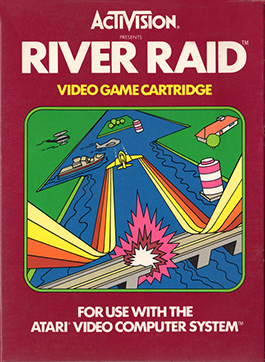
River Raid is a video game developed by Carol Shaw for the Atari Video Computer System and released in 1982 by Activision. The player controls a fighter jet over the River of No Return in a raid behind enemy lines. The goal is to navigate the flight by destroying enemies while collecting fuel and not crashing.

Pitfall II: Lost Caverns is a video game developed by David Crane for the Atari 2600. It was released in 1984 by Activision. The player controls Pitfall Harry, who must explore in wilds of Peru to find the Raj Diamond, and rescue his niece Rhonda and their animal friend Quickclaw. The game world is populated by enemies and hazards that variously cause the player to lose points and return to a checkpoint.

Grand Prix is a Formula One Grand Prix motor racing-themed video game. It was designed and programmed by David Crane for the Atari 2600 and published by Activision in 1982.

Ice Hockey is an ice hockey video game designed by Alan Miller for the Atari VCS, and published by Activision in 1981. Actor and comedian Phil Hartman starred in the commercial for the game.
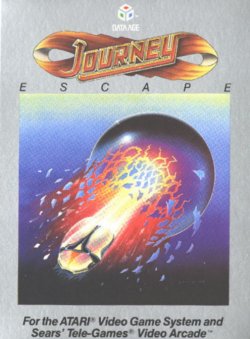
Journey Escape is a video game developed and manufactured by Data Age in San Jose, California for the Atari 2600 console, and released in 1982. It stars the rock band Journey, one of the world's most popular acts at the time, and is based on their album Escape.

Barnstorming is an Atari 2600 video game designed by Steve Cartwright and published by Activision in 1982. It was the first game designed by Cartwright. The idea for Barnstorming came to him as he watched a biplane one day while driving home from work.
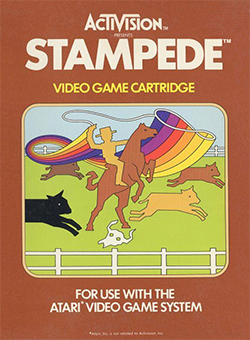
Stampede is a video game written by Bob Whitehead for the Atari Video Computer System and published by Activision in 1981. Stampede is a left-to-right, horizontally-scrolling, action game with a cattle round-up theme. An Intellivision version was released the following year.

Skiing is a video game cartridge for the Atari 2600. It was authored by Bob Whitehead and released by Activision in 1980. It's one of the first video games developed by Activision.
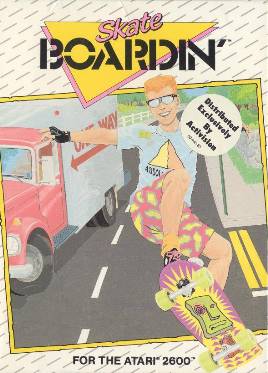
Skate Boardin', also known as Skateboardin' and Skate Boardin': A Radical Adventure, is a video game developed by Absolute Entertainment for the Atari 2600 and published in 1987 by Activision. It was written by Absolute co-founder David Crane, creator of the hugely successful Pitfall! It is one of the first skateboarding-based video games, preceded by at least the 720° arcade game and Skate Rock for the Commodore 64, both from 1986.
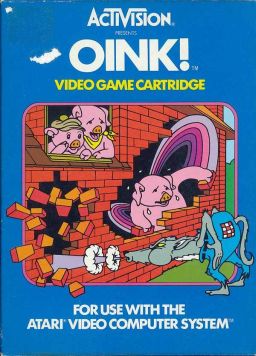
Oink! is an Atari 2600 video game designed by Mike Lorenzen and released by Activision in 1983. Oink! is inspired by the fairy tale "The Three Little Pigs" and casts the player as a pig defending his home from a wolf bent on destroying it.

Where in Europe Is Carmen Sandiego? is a 1988 European geography-based educational computer game in the Carmen Sandiego detective mystery franchise. It was originally published by Broderbund in 1988 for Apple II, Commodore 64, and DOS, and ported to the Amiga and Macintosh in 1989. It is the third Carmen Sandiego title, after Where in the World Is Carmen Sandiego? (1985) and Where in the USA Is Carmen Sandiego? (1986). Under the guidance of The Acme Agency's chief, the player completes cases to catch Carmen's henchmen; they accomplish this by traveling to European cities to find clues relating to the crook's last known whereabouts, and by gaining enough character data to issue a warrant of arrest. Once the player has captured all 15 thieves, they can pursue Carmen herself.

Dolphin is a side-scrolling video game created by Matthew Hubbard for the Atari 2600 and released by Activision in 1983. Dolphin requires the player to use audio cues in order to survive.
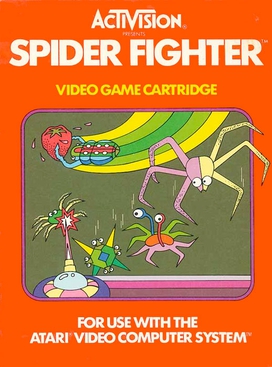
Spider Fighter is a fixed shooter designed by Larry Miller for the Atari 2600 and published by Activision in 1982. The object of Spider Fighter is to protect an orchard containing fruit—grapes, strawberries, oranges, and bananas—from four kinds of bugs. Digital Press described it as "much like the coin-op game Stratovox but w/o the voice."

Pitfall II: Lost Caverns is a 1985 arcade game developed by Sega. It was based upon Activisions two home console games Pitfall! (1982) and Pitfall II: Lost Caverns (1984) for the Atari 2600. It was described by historian Brett Weiss as a "rare occurrence" of an Arcade game being influenced by a console game.
